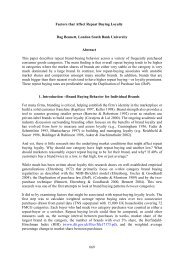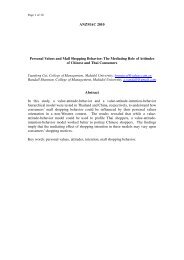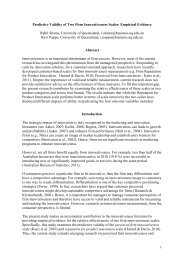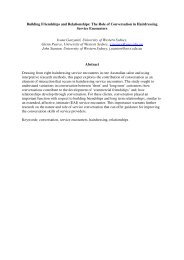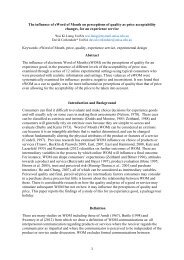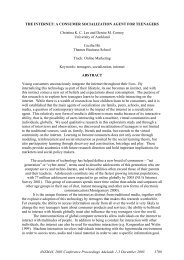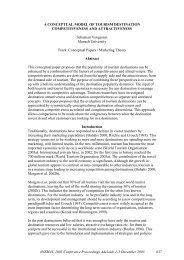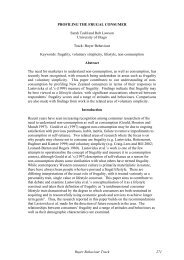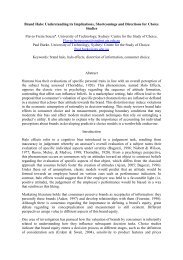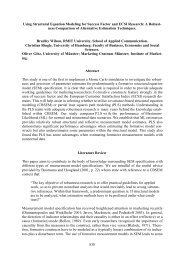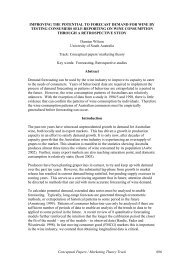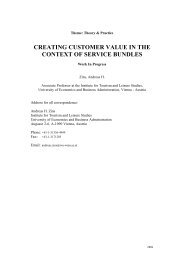amj Australasian Marketing Journal - ANZMAC
amj Australasian Marketing Journal - ANZMAC
amj Australasian Marketing Journal - ANZMAC
You also want an ePaper? Increase the reach of your titles
YUMPU automatically turns print PDFs into web optimized ePapers that Google loves.
the product of fashion clothing and its purchase decision.<br />
The motives for fashion clothing consumption were affected<br />
differentially by age and gender. The image motive which<br />
tapped the individuals motives to ensure social approval and<br />
pleasure motive which focused largely on the sensory gratification<br />
(Rossiter & Percy, 1997) and functional motive which<br />
focused on the functionality of fashion clothing (warmth,<br />
comfort, durability). Gender only had a significant effect on<br />
driving desires for social approval via image maintenance and<br />
was much stronger in females. Both age and gender had<br />
significant effect on pleasure, which was focused on sensory<br />
gratification and internally focused. It was females and<br />
younger respondents that were dominant here. The functional<br />
motive focusing on the functional attributes of fashion clothing<br />
were not significantly affected by age or gender. What is<br />
interesting to note is the higher levels or focus on functionality<br />
for fashion (mean score 4.25) compared to both imagepleasure<br />
motives that focused on firstly social approval (mean<br />
score 2.72) and secondly sensory gratification (mean score<br />
2.41). The influence of functionality in fashion clothing<br />
whilst not significant is still important. Such importance is<br />
seen in the mean score and indicates a strong requirement for<br />
functionality even in fashion clothing. So all respondents<br />
sought functionality in their clothing. Self-monitoring and<br />
materialism were both significant predictors of symbolic and<br />
pleasure consumption motives for fashion clothing.<br />
Browne and Kaldenberg (1997) also tested and found a relationship<br />
between self-monitoring characteristics of<br />
consumers and their materialistic tendencies. The findings<br />
here also indicate that self-monitoring does have an effect on<br />
materialism, but not as large as identified by Browne and<br />
Kaldenberg (1997). Therefore, the nature of the high selfmonitor<br />
to use products as props to convey an image is also<br />
confirmed here. That is high self-monitors are also apt to see<br />
products as central in their lives and to be acquisitive, have<br />
positive attitudes related to acquisition and to place a high<br />
priority on material possessions (such as fashion clothing).<br />
This characteristic in the self-monitor-materialist (high<br />
possession of both characteristics), implies a tendency to see<br />
products as not only props, but also to derive happiness, see<br />
them as a sign of success and place products in central and<br />
prominent position to convey a certain required image, allowing<br />
a chameleon like nature is supported.<br />
The important aspects of fashion clothing for the majority of<br />
respondents appears to be utility (function), but for materialists<br />
it is the ability to convey status, success and prestige and<br />
give pleasure. Fashion clothing consumption appears to be<br />
particularly susceptible to differences in consumption stereotyping,<br />
and therefore to differences in ability to encode and<br />
decode a range of messages for the fashion involved. This was<br />
also emphasised by Auty and Elliott (1998), and suggests that<br />
consumers with stronger materialistic (and self-monitoring)<br />
tendencies use fashion clothing for impression management,<br />
Fashion Clothing Involvement<br />
place it in a central position in life, use it to convey success<br />
and derive happiness from its consumption. The results indicate<br />
that greater levels of materialism seem to be associated<br />
with an understanding by individuals that possessions serve a<br />
communication or signal to others informing them of who the<br />
individual is and what their status or position is, much as a<br />
high self-monitor does.<br />
On this point Browne and Kaldenberg (1997) argued that,<br />
people who are more materialistic, are also likely to be high<br />
self-monitors, making a strong connection between materialism<br />
and self-monitoring characteristics in consumers. They<br />
also indicated that both materialism and self-monitoring affect<br />
product involvement. However, the results here indicate that<br />
all variables that were predicted to have an effect on product<br />
involvement and purchase decision involvement did, except<br />
for self-monitoring. Self-monitoring was not a predictor of<br />
fashion involvement in comparison to all other independent<br />
variables. The results clearly indicate that the social motive of<br />
social approval derived through the product is the strongest<br />
driver of involvement in fashion clothing, followed by sensory<br />
gratification, gender and age and materialism were fairly<br />
similar in their effects, except for the age effect on purchase<br />
decision involvement which was not significant.<br />
The findings of this study in part support the work of Browne<br />
and Kaldenberg (1997) and Auty and Elliott (1998), however<br />
they also indicate differences and contradictions. For example,<br />
Auty and Elliott s (1998) claim that self-monitoring is a surrogate<br />
for involvement seems misleading at best and wrong at<br />
worst, given the nature of the findings of the present study.<br />
This is so because it was shown here that the effect was not<br />
significant in relation to the other independent variables tested.<br />
It also indicates that further research is warranted on this topic.<br />
9. Limitations<br />
There are some limitations given the nature of the sample<br />
(students) and the use of a single product. However, as identified<br />
earlier the sample is acceptable for theory testing (e.g.,<br />
see, Calder, Philips and Tybout, 1981 and Ferber, 1977). The<br />
study may also be limited by the use of a single product (fashion<br />
clothing), however other studies have also used single<br />
products (Arora, 1982; Fairhurst, Good and Gentry, 1989;<br />
Mittal and Lee, 1988; Slama and Tashchian, 1987; Tigert,<br />
Ring and King, 1980; O Cass, 2000). Further, given that<br />
Browne and Kaldenberg (1997) also used a single product,<br />
namely fashion clothing and one of the objectives of this<br />
study was to re-examine the same constructs using the same<br />
product the use of fashion clothing is not considered to be a<br />
major problem. This paper presents a reexamination of the<br />
Browne and Kaldenberg (1997) study using the same product<br />
class (fashion clothing), but with what are argued to be more<br />
psychometrically sound measures. Further research is now<br />
needed to extend this work into other product categories and<br />
perhaps bring the focus down to a brand level as Auty and<br />
Elliott (1998) did.<br />
<strong>Australasian</strong> <strong>Marketing</strong> <strong>Journal</strong> 9 (1), 2001 57



